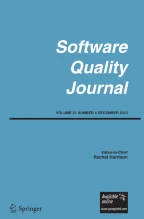Abstract
This paper describes our attempts to look at how different cultures influence Software Quality Management (Siakas 1996; Mohamed Walaa-Eldeen and Siakas 1996). Quality of the software product cannot be determined until late in the development cycle. It is widely accepted that reliance has to be placed on process quality as a means of achieving product quality. In recent years software organisations have been making efforts concentrating on improving the process in order to improve software quality. Hofstede (Hofstede 1994) had defined four dimensions of work-related value differences for classifying cultural influences in different countries. These are: power distance, collectivism/individualism, femininity/masculinity and uncertainty avoidance. In this paper software development organisations are being assessed for their awareness and acceptance of Software Quality. These results will be correlated with the work-related values identified by Hofstede. The intention is to identify cultural factors, which may have a bearing on successful adoption and implementation of Software Quality Management.
Similar content being viewed by others
References
Boström, R. P. 1997. MIS problems and failures: a socio-technical perspective. Part I: the causes, MIS ¨ Q., September, pp. 17–32.
Curtis, B., Heflleey, W. E., and Miller, S. 1995. Overview of the people, capability maturity model, CMUrSEI 95-MM-01. ]
Fisher, G., Verveers, F., and Drenth, Y. 1996. A software process and product improvement model. 5th Software Quality Conf. Dundee, Scotland, 9–11 July.
Haase, V. H. 1992. Bootstrap: measuring software management capabilities, first findings in Europe, Fourth IFACrIFIP Workshop, Austria, May.
Haase, V. and Mesnarz, R. 1994. Bootstrap: fine-tuning process assessment. IEEE Software, July, pp. 25–35.
Hall, E. T. 1959. The Silent Language, New York, Doubleday.
Hirschheim, R. A. 1992. Information systems epistemology: an historical perspective, in Galliers. Information Systems Research, Issues, Methods and Practical Guidelines, Blackwell.
Hoecklin, L. 1995. Managing Cultural Differences, Strategies for Competitive Adv antage, Reading, MA, Addison-Wesley.
Hofstede, G. 1994. Cultures and Organisations, Intercultural Cooperation and Its Importance for Survival, Software of the Mind, UK, McGraw-Hill International.
Hodge, B. J. and Anthony, W. P. 1988. Organisational Theory, Boston, Allyn and Bacon.
Humphrey, W. S. 1989. Managing the Software Process, Reading, MA, Addison-Wesley.
Humphrey, W. 1995. A Discipline for Software Engineering, Reading, MA, Addison-Wesley.
Jack, R. 1997. Personal issues in software cost estimation, 5th Software Quality Conf., Dundee, Scotland, 9–11 July.
Jarvinen, J. 1994. On comparing process assessment results: BOOTSTRAP and CMM Software Quality ¨ Management, SQM94, Edinburgh, pp. 247–261.
Joynt, P. and Warner, M. 1996. Introduction, in Joynt, P. and Warner, M., Eds. Cross-Cultural Perspectives in Managing Across Cultures: Issues and Perspectives, International Thomson Business Press.
Kondo, Y. 1995. Importance of employee motivation in TQM, 5th World Cong. on Total Quality, New Delhi, February, pp. 46–52.
Lessem, R. 1989. Global Management Principles, London, Prentice-Hall.
Lofland, J. and Lofland, L. H. 1995. Analytic Social Settings, A Guide to Qualitative Observation and Analysis, Belmont, CA, Wadsworth.
Mohamed, Walaa-Eldeen A. and Siakas, K. V. 1995. Assessing software quality management maturity (SQMM): a new model incorporating technical as well as cultural factors. 3rd Int. Conf. on Software Quality Management SQM95, Seville, April.
Orlikowski, W. J. and Baroudi, J. J. 1991. Studying information technology in organisations: research approaches and assumptions, Inform. Syst. Res. 2(1), 1–28.
Oyen, E. 1992. Comparative Methodology, Theory and Practice in International Social Research, Thousand Oaks, CA, Sage.
Oppenheim, A. N. 1996. Questionnaire Design, Interviewing and Attitude Measurement, London, Pinter.
Paulk, M. C. 1993. Comparing ISO 9001 and capability maturity model for software, Software Quality J. 2:245–256.
Paulk, M. C., Curtis, B., and Chrissis, M. B. 1993. Capability Maturity Model, Version 1.1, IEEE Software, July, pp. 19–27.
Ross, M. and Staples, G. 1995. Maintaining quality awareness, 3rd Int. Conf. on Software Quality Management, SQM95, Seville, April, pp. 369–375.
Rout, T. P., Nielson, M. P., and Gasston, J. L. 1994. Experiences with the use of different approaches to software process assessment, Software Quality Management, SQM94, Edinburgh, pp. 767–779.
Rout, T. 1995. P. SPICE: a framework for software process assessment. Software Process-Improvement Pract., pilot issue, pp. 57–66.
Sanders, M. (Ed.). 1998. The SPIRE Handbook, Better, Faster, Cheaper Software, Development in Small Organisations, SPIRE project, The European Community, ESPITrESSI 23873.
Siakas, K. V. 1996. The effect of cultural factors on the implementation of software quality management systems. 5th Software Quality Conf., Dundee, Scotland, 9–10 July.
Siakas, K. V., Berki, E., Georgiadou, E., and Sadler, C. 1997. The complete alphabet of quality software systems: conflicts and compromises, 7th World Cong. on Total Quality & Qualex 97, New Delhi, India, 17–19 February.
Strauss, A. and Corbin, J. 1997. Grounded Theory in Practice, Thousand Oaks, CA, Sage.
Author information
Authors and Affiliations
Rights and permissions
About this article
Cite this article
Siakas, K.V., Georgiadou, E. & Sadler, C. Software Quality Management from a Cross-Cultural Viewpoint. Software Quality Journal 8, 85–95 (1999). https://doi.org/10.1023/A:1008948709011
Issue Date:
DOI: https://doi.org/10.1023/A:1008948709011
